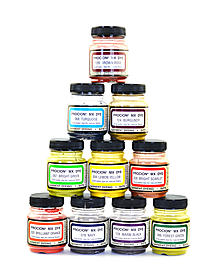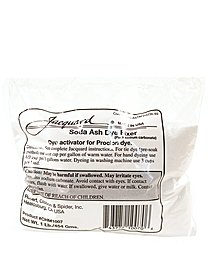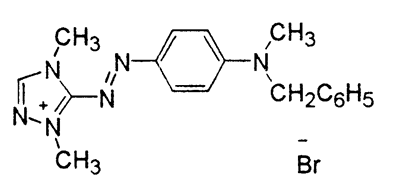My daughter is highly allergic to red dye #46. Is there a way to determine whether or not this dye is in clothing?
Name: Stephanie
—ADVERTISEMENTS—
Procion Dyes are hypoallergenic to the wearer, after the initial washing-out of excess dye has been completed
This kit includes 3 small jars of dye, plus soda ash, which is used to permanently fix the Procion dye to the natural fiber
Large 8-ounce jars of Procion black dye are more economical; don't forget to purchase soda ash, as well!

Procion MX Fiber Reactive Dye warm black 128 8 oz.


Soda Ash Dye Fixer, one pound
Large 8-ounce jars of Procion black dye are more economical; don't forget to purchase soda ash, as well!

Procion MX Fiber Reactive Dye warm black 128 8 oz.

Soda Ash Dye Fixer, one pound
Country or region: North America, USA
Message: Good Morning,
My daughter is highly allergic to red dye #46. Is there a way to determine whether or not this dye is in clothing? She avoids clothing that is red, purple, orange, or dark brown, but does prefer black (just has to be careful). For her to come in contact with this dye would be like you and I coming in direct contact with poison ivy. Any help would be greatly appreciated! Samantha has not been rash free in over 9 years. I took us 8 years to discover the cause of her rash. Unfortunately, clothing is not required to state what colors are used in the dying process. Again help or resources would be greatly appreciated!
You must be referring to Colour Index Basic Red 46, which happens to be one of the most allergenic of textile dyes. (In addition to the color, red, and the number, 46, you must specify the class of dyes, in this case basic, or cationic, in order to name the dye.) Not only is basic red 46 allergenic in itself, but, because it is one of the basic (or cationic) dyes, it does not form tight bonds to the fiber, so some of the dye will transfer from the garment to the wearer's skin. Because of their positive molecular charge, basic dyes are then more easily absorbed into the body than negatively charged dyes such as reactive dyes or acid dyes.
Basic dyes are most commonly used to dye acrylic yarn. This means that synthetic-fiber socks and sweaters are the greatest threat to your daughter. Avoid all clothing that contains any acrylic fiber. Other names for acrylic include names such as Orlon, Courtelle, Dralon, Leacryl, and Nitron.
Basic dyes are less commonly used in polyester or nylon, but it is possible that some modified polyesters and nylons might be dyed with basic dyes. It would be safest for your daughter to avoid synthetic-fiber clothing in general, although most polyesters and nylons will be okay.
Natural fiber clothing will almost always be safe for your daughter. While it is possible to use basic dyes to dye natural-fiber fabrics, by using mordants, which are not needed with better dyes, or by first dyeing with direct dyes and then with basic dyes, I'm inclined to think that manufacturers no longer do so. Manufacturers of well-dyed clothing would not. Basic dyes can produce very bright colors even on natural fibers, but they function badly on them as dyes, being much more suited for dyeing certain synthetic fibers. Since they do not bond directly to the cotton fiber, they fade quickly, and can be washed out of cotton by repeated washings in hot water. A dye supplier in the UK, Mistral Chemicals, lists the uses of this dye as being for acrylon (an acrylic-based fabric), wool, silk and textile printing, and, oddly, as being used as a permanent dye for prawns and other fishing bait, although they add "PLEASE NOTE: This product is not for human or animal consumption."
Socks and sweaters are going to be the biggest challenges for your daughter, since acrylic fiber is so frequently used in these garments. Synthetic yarn used for hand knitting is almost always acrylic; good wool yarn, which will be safe, is available for a higher price. She will probably be okay with 100% wool socks, and also cotton socks that contain spandex, a synthetic stretch fiber. Spandex is often left undyed, with the threads spun in such a way that the cotton fiber covers the spandex fibers so that they do not need to be dyed; when it is dyed, spandex is normally dyed with metal complex acid dyes, which are an entirely different category of dyes from the one your daughter is allergic to.
If you want to be certain of clothing that is dyed with non-allergenic dyes, buy undyed clothing that is made of cotton or rayon (including bamboo fiber, which is a type of rayon), or 100% real silk, and dye it yourself using fiber reactive dyes, such as the Procion dyes that are very popular for use in tie-dyeing. Procion dyes are hypoallergenic to the wearer, because fiber reactive dyes form a permanent chemical bond to the cotton, rayon, or silk fiber, and will never wash out, once you have washed them a few times in hot water to get out all loose unattached dye. The same is true of the Dylon Permanent Dyes (look for the word "permanent" in the name), which are available in many crafts or sewing stores. Because the chemical bond between dye and fiber is so strong, the dye does not leach out onto the wearer's skin the way basic dyes do, so new allergies will not form to fiber reactive dyes, as the result of wearing clothing that has been dyed with them. The only allergy problem with fiber reactive dyes occurs when workers breathe the dye powder, or if the clothing is not washed at all after dyeing, but you can easily take precautions so that you are not exposed to the dye powder while you are using it for dyeing.
Take a look at the wide variety of undyed clothing blanks sold by Dharma Trading Company, from dresses to t-shirts. Dharma Trading Company is also an excellent source for Procion dyes. I particularly like their bamboo socks, for kids and adults. You can dye them different solid colors in buckets, or experiment with multi-color methods such as tie-dye or LWI. Your daughter might like to have an entire washing machine load of different cotton and rayon clothing, all dyed solid black at once with Procion dye. This dye will not harm your washing machine, but it is easier to use in a top-loading washing machine than in a front-loader. Check the instructions for washing machine dyeing to determine how much dye to order.
Hair dye is another issue to beware of. The 2009 book A Consumer's Dictionary of Cosmetic Ingredients, 7th Edition: Complete Information About the Harmful and Desirable Ingredients Found in Cosmetics and Cosmeceuticals, by Ruth Winter, lists Basic Red 46 as an ingredient in hair dye. If your daughter ever dyes her hair, she must take care to do the recommended skin patch test a few days beforehand, to be sure that the dye she has chosen does not contain the dye she is allergic to. If she has her hair dyed in a salon, this will require an extra trip to the salon for the test application. Since it can take several days after exposure for symptoms to appear, this will require some planning ahead.
AllergEaze, a company that creates the samples used by allergists for testing patients, provides information sheets about specific allergens on their website. Their page on Basic Red 46 includes some information at the end about disperse dyes, which, as these are an entirely different class of dyes, is not applicable to Basic Red 46, but their information about basic red 46 itself is useful. In their PDF, they say:
"Basic red 46 is a dark red powder dye used in wool, silk, acrylic/cellulosic
(cotton or linen) fiber blends, polyester and acrylic textile printing (sweaters,
shirts, socks etc.) Allergic patients should avoid contact with these materials,
wash new clothing or bed linens multiple times before use, and wear fabric
made of natural fibers such as silk, wool, and cotton. Wear loose fitting clothes
if possible and avoid nylon stockings especially dark colors. Wash new clothing
or bed linens twice before use. Wash all new clothes and bed linens three
times before using. Try to wear natural-based fabrics, silk, cotton, and wool.
Long sleeve white silk underwear can be worn if certain outer wear fabrics
cannot be avoided. Levi Strauss 501 blue jeans usually do not cause dermatitis
in dye-sensitive individuals."
Below is a picture of the chemical structure of Colour Index Basic Red 46, from the dye manufacturer World Dye Variety.

Its CAS Registry Number is 68893-91-4. Another name for it is cationic red X-GRL. Its chemical name can be expressed in several different ways, including 1,2(4)-Dimethyl-3(5)-((4-(methyl(phenylmethyl)amino)phenyl)azo)-1,2,4-triazolium bromide, or, in another naming method, N-benzyl-4-[(1,4-dimethyl-1,5-dihydro-1,2,4-triazol-1-ium-5-yl)diazenyl]-N-methylaniline bromide. Well-known brands of basic dyes that include this dye are Orcozine Red GRL, from Organic Dyestuffs; Permacryl Red FBL-A and Permacryl Fast Red GRL, from Standard Dyes; Maxilon Red GRL, formerly manufactured by Ciba Specialty Chemicals Inc; and Astrazon Red FBL, part of the Astrazon line of basic dyes available from the artist's dye retailer Batik Oetoro in Australia. An MSDS provided by Mistral Chemicals, for those working with this dye, lists for the standard hazard symbols of Xn/Xi (Harmful); R22 (Harmful in contact with skin and if swallowed); R36/38 N (Irritating to eyes and skin); and R51/53 (Toxic to aquatic organisms, may cause long-term adverse effects in the aquatic environment).
I hope your daughter will be able to be rash-free by avoiding this dye.
Posted: Tuesday - June 17, 2014 at 10:41 AM
Follow this blog on twitter here.
Quick Links
- All About Dyes & Dyeing Top -
- Top of this blog -
- FAQ -
- The Dye Forum -
- How to Tie Dye - How to Batik -
- Books - Toys - Plants -
- Top of this blog -
- FAQ -
- The Dye Forum -
- How to Tie Dye - How to Batik -
- Books - Toys - Plants -
More in this category:
- -
Statistics
Total entries in this blog:
Total entries in this category:
Published On: Jun 17, 2014 11:27 AM
Total entries in this category:
Published On: Jun 17, 2014 11:27 AM
